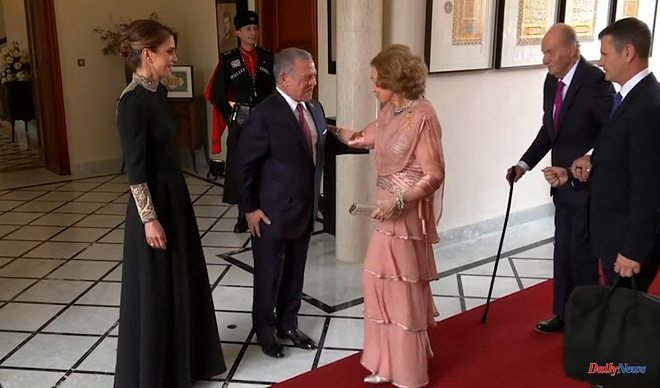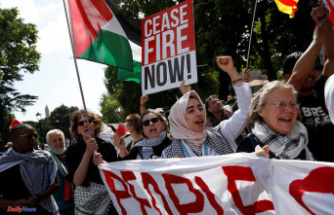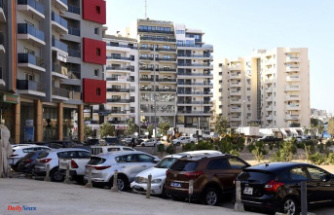The last wedding of a crown prince in Jordan until this Thursday was held almost two decades ago. The same Zahran Palace -in Amman, the capital of the country- in which Hussein, the eldest son of King Abdallah and Queen Rania, and the Saudi-born architect Rajwa Al-Saif, both 28 years old, say yes today. , was the setting in which in 2004 the lavish banquet was held on the occasion of the wedding of Prince Hamzah and his cousin Noor.
Hamzah, son of the by then deceased King Hussein and his last wife, the American and media Noor, would lose that title of crown prince just a few months later. His stepbrother, the monarch, decided to break the supposed last will of his father and a few years later followed his own plans and designated his firstborn son as his clear successor, now the protagonist of the great royal wedding of the year
In between, the Hashemite Court has experienced moments of great convulsion due to games of thrones that have left victims along the way, including an attempted palace coup led by the aforementioned Hamzah in 2021 that ended with his arrest, his subsequent public request for forgiveness from his brother and, finally, his resignation from the title of prince for his rejection of the way of governing of the current Jordanian authorities, whom he did not hesitate to accuse of being "corrupt".
All this complicated political background is inevitably present in this Jordanian royal wedding. This Middle Eastern country has played an important role in the unstable balance of the regional board for decades and is the only Monarchy that does not swim in hydrocarbons in the area.
And the Jordanians have overturned in recent weeks with all the splendors that have preceded the heir's grand royal wedding. All conspired not to remember in public the dynastic intrigues, the disowned Hamzah or the loser queen widow Noor, who is neither there nor expected in the lands of which she became her new homeland.
But, like any marriage of a royal heir, it escapes no one that it is a state event with which, above all, the Hashemite dynasty intends to launch an image of stability and continuity to the world, without losing sight of that in Amman they are very interested in refining their relations with Riyadh, relying on the Saudi origin of the new crown princess consort.
Representatives of numerous royal families from around the world, especially European and naturally from the Middle East, have gathered in Amman to give their support to Kings Abdallah and Rania and the bride and groom. The Spanish case powerfully draws attention. Despite the very close relationship for many decades between the Hashemite dynasty and the Bourbons, Zarzuela has incomprehensibly been distracted at all times, hiding behind the fact that it is a private event, as if the wedding of a crown prince in a reigning Monarchy was not a political event of the first magnitude. Neither Don Felipe nor Doña Letizia have been displaced to Amán and the opportunity for the crown princess, Leonor, to make her debut before global royalty has been wasted. She represents our Doña Sofía Royal Family at the wedding, who attends accompanied by Don Juan Carlos. The Emeritus meet again like this after seeing each other at the funerals for Constantine of Greece last January in Athens. Although from Zarzuela, in an unofficial way, they have wanted to emphasize that Juan Carlos I attends the wedding in a personal capacity and not on behalf of the Spanish Bourbons. All quite Kafkaesque. Anyway.
And, beyond ours, the guest list is quite extensive. The Windsors this time have lived up to it and have sent the heirs, Princes William and Catherine, to Amman. And, along with them, a very long list from Götha: King William and Máxima of the Netherlands, along with their eldest daughter Amalia; King Philip of the Belgians with the heiress Elizabeth; Prince Sebastián of Luxembourg -who coincided with Hussein at the Sandhurst Military Academy, in the United Kingdom-; Frederick and Mary from Denmark; Prince Haakon of Norway; Princes Victoria and Daniel of Sweden; the kings of Malaysia, Sultan Hassanal Bolkiah of Brunei; custody of the Romanian Crown Margarita and her husband Radu; Prince Regents Alois and Sofia of Liechtenstein; the Japanese princess Hisako of Takamado with her daughter Tsuguko, the crown prince of Oman and Bahrain, the queen of Bhutan, the spectacular Sheikha Moza bint Nasser of Qatar...
There has also been no shortage of other important international figures, such as the first lady of the United States, Jill Biden. Let's not forget that Amman is one of Washington's main allies in the troubled region.
At 3 in the afternoon (Spanish time) the 140 guests for the religious ceremony began to arrive at the Zahran Palace. All received by Kings Abdalá and Rania, who wears a long kaftan in dark tones. The bride and groom have said yes in an elegant and short ceremony, following the Muslim rite, in the gardens of the Palace (built in 1957), under the watchful eye of the representatives of royalty.
Prince Hashem (the groom's younger brother) has acted as Rajwa Al Saif's companion on the promenade to the place adapted for the ceremony, where her father, Prince Hussein and King Abdallah were waiting for her, all three in their corresponding places next to the religious cleric.
The bride, as usual, has been the last to arrive at Zahran's Palace. She has done it in a 1968 Rolls-Royce Phantom V that was custom built for the late Queen Zein al-Sharaf, the great-grandmother of whom she is now her husband.
Rajwa Al Saif has dazzled with a dress with an asymmetrical neckline, long sleeves and a silhouette that gently hugs her figure, signed by the Lebanese dressmaker Elie Saab, one of the most recognized figures of international haute couture and one of Queen Rania's favorites.
Elie Saab was also dressed by the Princess of Wales, Catalina, in a long pale pink dress. All the guests have attended with dresses to the feet as required by the protocol to witness the Muslim ceremony.
Next, the newlyweds toured the main avenues of Amman, well decked out for the occasion, in one of the dynasty's convertible cars, just as the groom's parents, then-Prince Abdallah, and the woman born in Kuwait of Palestinian origins with whom he fell in love: Rania Al-Yassin. Although he was King Hussein's eldest son, he was not crown prince at the time and it was not clear that he would ever occupy the throne.
The great invitation of this royal wedding, attended by 1,700 guests, will take place in another royal residence in Amman, the Al Husseiniya Palace, the official headquarters of the Hashemite Monarchy, where the sovereign's work offices are located.
The entire evening will be enlivened by performances by local and regional singers, Jordanian choirs and bands, the national orchestra and folk dance groups. Various numbers will pay tribute to the crown prince's military career, his girlfriend's Saudi Arabian heritage and traditional Jordanian art.
And, as in any western-style wedding worth its salt, the most significant moment will come when the newlyweds cut the gigantic wedding cake.
On Wednesday night, the eve of the wedding, King Abdullah hosted a dinner in honor of his eldest son, attended by more than 4,000 attendees representing all segments of the country's society. The monarch presented his eldest son with the Hashemite sword, a symbol of justice, which is a copy of the sword of Abdullah I made in 1916. The new piece has been made with iron extracted from the stones that surround the castle of Ajlou . "28 years ago, our almighty lord blessed me with Hussein, and today I am proud of him. I am proud of his determination and great ambition for his country and his love and devotion for his family," said an emotional monarch about his successor. .
In the same setting of that massive banquet, the Madareb Bani Hashem, last week the traditional henna festival that Queen Rania organized for her daughter-in-law took place. The important event was attended by all the females of the Hashemite dynasty, with the exception of the widowed queen Noor and her two daughters. Nobody expected them but impossible not to remember them.
According to the criteria of The Trust Project












